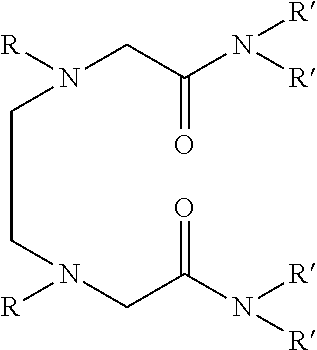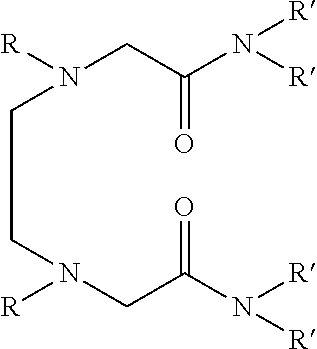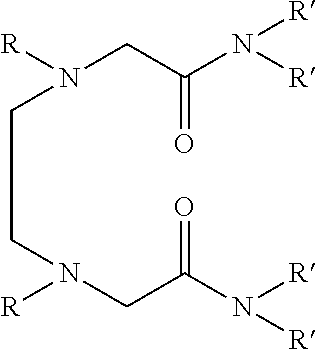Dialkyldiaza-tetraalkyloctane diamide derivatives useful for the separation of trivalent actinides from lanthanides and process for the preparation thereof
a technology of diamide and diaza-tetraalkyloctane, which is applied in the field of new lipophilic extractants, can solve the problems of limiting the use difficult group separation of trivalent actinides from lanthanides, and susceptibility to degradation
- Summary
- Abstract
- Description
- Claims
- Application Information
AI Technical Summary
Benefits of technology
Problems solved by technology
Method used
Image
Examples
example 1
Synthesis of N,N,N′,N′-tetra(2-ethylhexyl)-3,6(N″,N′″dibutyl)diaza-octane 1,8 diamide
[0051]209 ml (1.0 mol) of N,N′-dibutylethylenediamine, 785 ml (2.45 mol) of N,N-(2-ethylhexyl)-2-chloroacetamide and 900 ml (6.45 mol) of triethylamine are mixed together and well stirred at room temperature under nitrogen atmosphere. The temperature of the reaction mixture is slowly raised and refluxed at 85° C. for 48 hours under vigorous stirring. The progress of the reaction was monitored by GC-MS. On cooling the reaction mixture is diluted with xylene and neutralized with 1.0M hydrochloric acid. The organic phase is separated and washed with water and 2.0% sodium carbonate solution and further washed with water to neutral pH. The organic is dried with anhydrous sodium sulphate and concentrated by distillation under reduced pressure. The residue is further distilled at 140° C. under vacuum of about 1.0 millitorr using centrifugal molecular distillation unit to remove the unreacted N,N-(2-ethylhe...
example ii to vi
[0060]The procedure of example 1 was repeated for synthesis of various diazaoctanediamides where a given N,N′-dialkylethylenediamine is reacted with different alkyl substituted chloroacetamide. They are indicated in Table 1,
TABLE 1Sr.N,N′ dialkylethylenediamineN,N,diakyl-2-No.ExampleAlkylchloroacetamide Alkyl1IIMethyla. isobutylb. hexylc. 2-ethylhexyl2IIIEthyla. isobutylb. hexylc. 2-ethylhexyl3IVPropyla. isobutylb. hexylc. 2-ethylhexyl4VButyla. isobutylb. hexylc. 2-ethylhexyl5VIPentyla. isobutylb. hexylc. 2-ethylhexyl
example vii
[0061]In this example, use is made as the solvent formed by dissolving N,N,N′,N′-tetra (2-ethylhexyl) 3,6-(N″,N′″dibutyl)diaza-octane 1,8 diamide in 1-octanol to a concentration of 0.1M.
[0062]To perform extraction, this organic solvent is brought into contact with nitric acid solution at pH 2.5 containing 1 mg / 1 Am, 50 mg / 1 Eu, 200 mg / 1 La, 200 mg / l Ce, 0.25 M NaNO3. After agitation for 30 minutes, and the decantation of two phases, the americium and lanthanides content of each phase is measured to determine the distribution co-efficients and separation factors. All experiments are carried out at aqueous to organic phase ratio of one and at ambient conditions.
[0063]Table 2 shows the results of the extraction studies.
TABLE 2Sr.Distribution co-efficient Separation FactorNo.ElementsDM(DAm / DLn's)1Am1.582.Eu0.13????12.153.Ce0.33347.874.La0.02368.70
[0064]The other preferred compound namely N,N,N′,N′-tetra(2-ethylhexyl) 3,6-(N″,N′″dipentyl)diaza-octane 1,8 diamide has shown similar extract...
PUM
| Property | Measurement | Unit |
|---|---|---|
| Temperature | aaaaa | aaaaa |
| Temperature | aaaaa | aaaaa |
| Time | aaaaa | aaaaa |
Abstract
Description
Claims
Application Information
 Login to View More
Login to View More - R&D
- Intellectual Property
- Life Sciences
- Materials
- Tech Scout
- Unparalleled Data Quality
- Higher Quality Content
- 60% Fewer Hallucinations
Browse by: Latest US Patents, China's latest patents, Technical Efficacy Thesaurus, Application Domain, Technology Topic, Popular Technical Reports.
© 2025 PatSnap. All rights reserved.Legal|Privacy policy|Modern Slavery Act Transparency Statement|Sitemap|About US| Contact US: help@patsnap.com



